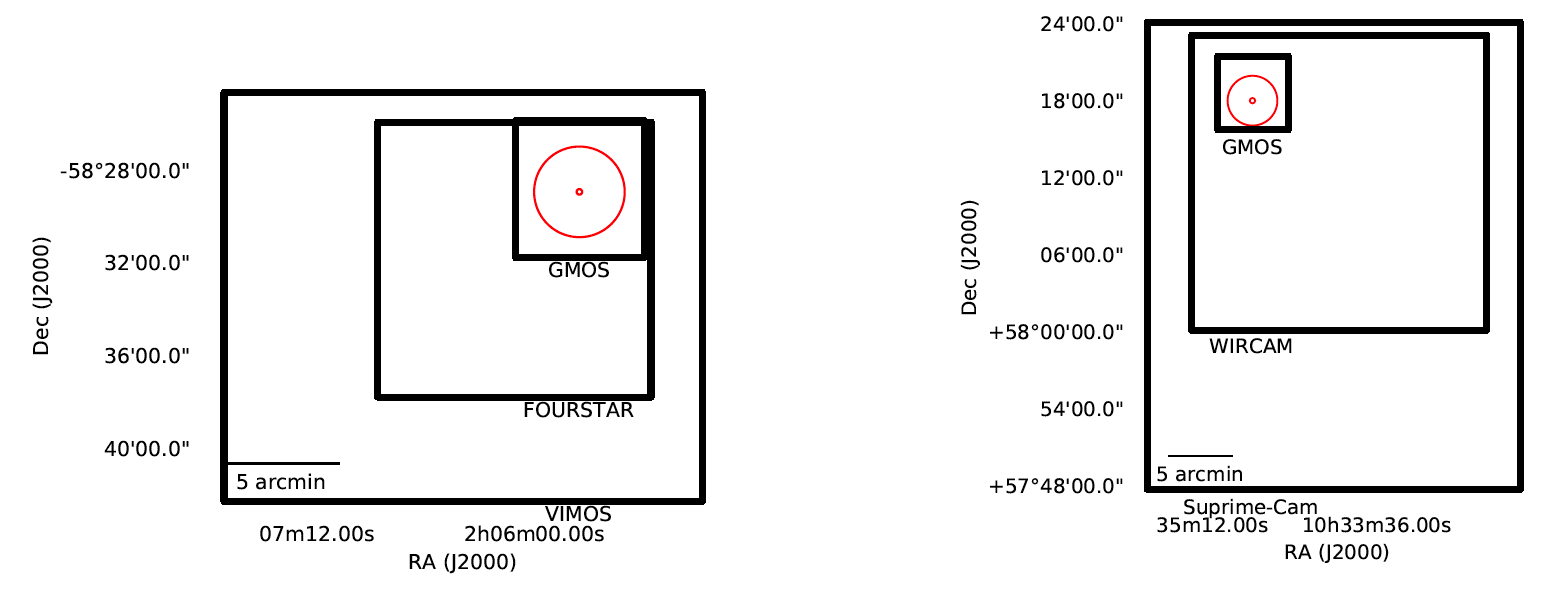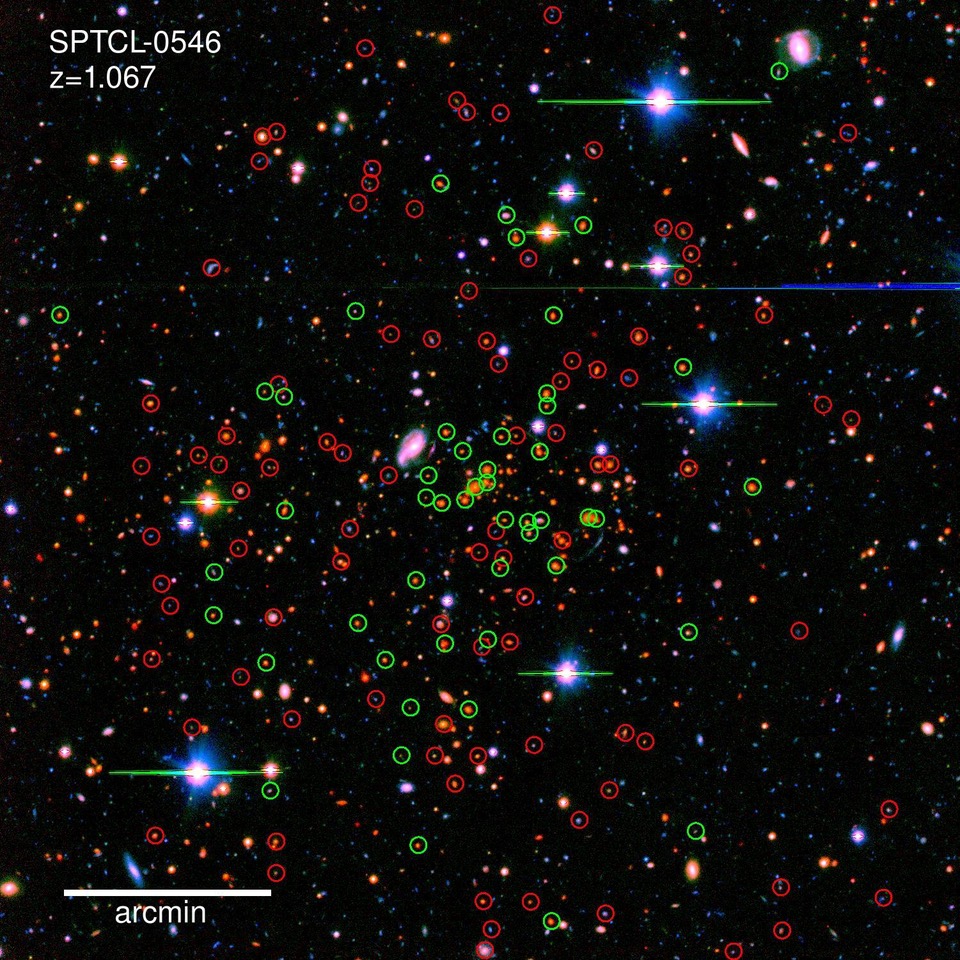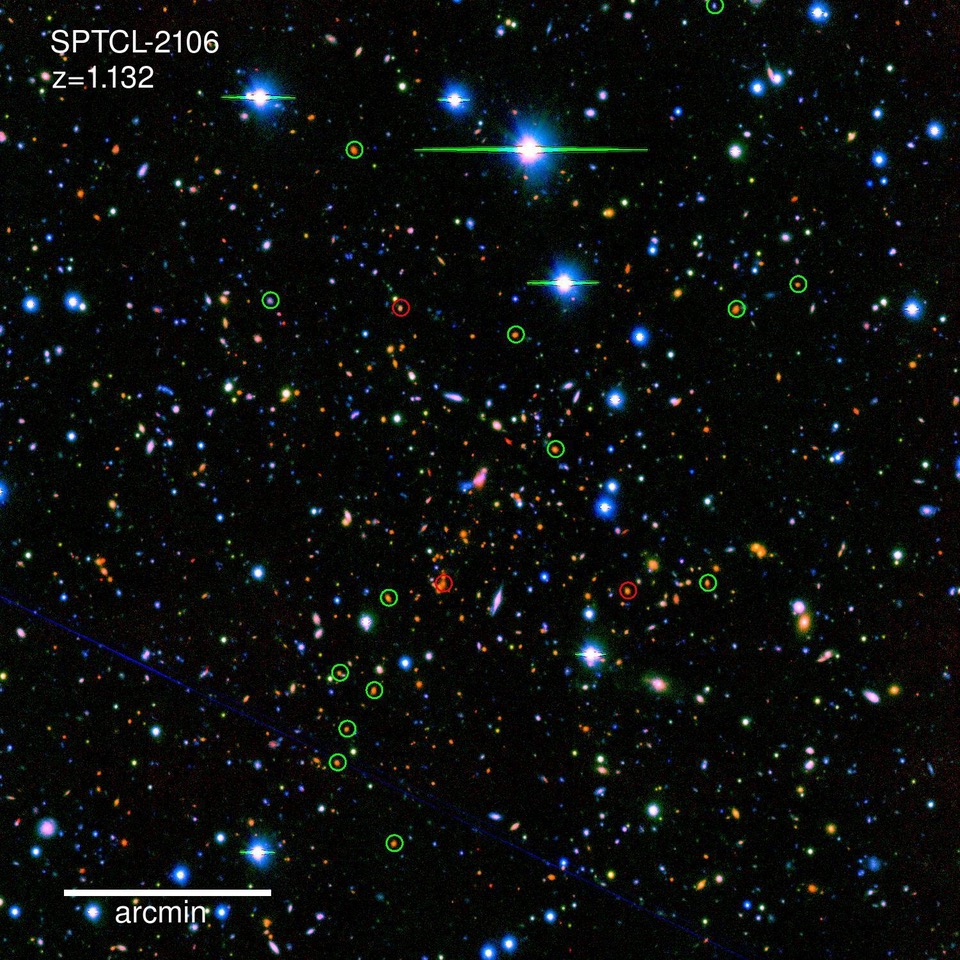Multiwavelength imaging is required both to quantify the spectroscopic completeness and to determine the stellar masses and star formation histories of our galaxies. In particular, broad wavelength coverage is crucial for classifying galaxies from their rest-frame colours. We also require good photometric redshifts to understand the relevant completeness for cluster members (van der Burg et al. 2013). Well calibrated photometric redshifts will allow us to determine membership at radii outside of those probed by our GMOS spectroscopy.
The nine group targets have existing deep, multiwavelength imaging spanning the full optical-NIR spectrum from COSMOS and SXDS, and we will obtain comparably deep coverage in the same bands (ugrizYJK) for the other systems. All but three of our clusters have publicly available deep (AB=23.1) [3.6]μm imaging from Spitzer IRAC. Most of the data come from SERVS (Mauduit et al. 2012), S-COSMOS (Sanders et al. 2007) and SpUDS (PI J. Dunlop, as described in Galametz et al. 2013). The three SPT clusters were observed as PI programs (PI Brodwin, from program ID 70053 and 60099). The remaining three clusters only had imaging from the shallow SWIRE (Lonsdale et al. 2003) survey. We therefore obtained 1200s/pixel integrations over 3×2 maps at [3.6]μm and [4.5]μm from Cycle 13 (PI McGee, GO program 13046).
Optical and NIR Imaging
| Cluster Target Depth (AB) | u/U | g/B/V 26.5 | r/R 26.5 | i/I 25.0 | z'/z 26.0 | Y/J1 24.5 | J 24.0 | Ks 23.5 | [3.6μm] 23.1 |
|---|---|---|---|---|---|---|---|---|---|
| SpARCS0035 | VIMOS | VIMOS | VIMOS | VIMOS | GMOS/VIMOS | Fourstar | HAWK-I | HAWK-I | SERVS |
| SPT0205 | VIMOS | VIMOS | VIMOS | VIMOS | GMOS/VIMOS | Fourstar | Fourstar | Fourstar | PI Brodwin |
| SpARCS0219 | VIMOS | VIMOS | VIMOS | VIMOS | GMOS/VIMOS | Fourstar | Fourstar | Fourstar | SERVS |
| SpARCS0335 | VIMOS | VIMOS | VIMOS | VIMOS | GMOS/VIMOS | HAWK-I | Fourstar | Fourstar | GOGREEN |
| SPT0546 | VIMOS | VIMOS | VIMOS | VIMOS | GMOS/VIMOS | Fourstar | Fourstar | Fourstar | PI Brodwin |
| SpARCS1033 | SuprimeCam | SuprimeCam | SuprimeCam | GMOS/HSC | HSC | (MMIRS) | (MMIRS) | GOGREEN | |
| SpARCS1034 | SuprimeCam | SuprimeCam | SuprimeCam | GMOS/HSC | HSC+WIRCAM | (WIRCAM) | WIRCAM | GOGREEN | |
| SpARCS1051 | Megacam | SuprimeCam | SuprimeCam | SuprimeCam | GMOS/HSC | HSC | (WIRCAM) | (WIRCAM) | SERVS |
| SpARCS1616 | Megacam | SuprimeCam | SuprimeCam | SuprimeCam | GMOS/HSC | HSC | (WIRCAM) | (WIRCAM) | SERVS |
| SpARCS1634 | Megacam | SuprimeCam | SuprimeCam | SuprimeCam | GMOS/(HSC) | (HSC) | (WIRCAM) | (WIRCAM) | SERVS |
| SpARCS1638 | Megacam | SuprimeCam | SuprimeCam | SuprimeCam | GMOS/(HSC) | (HSC) | SERVS | ||
| SPT2106 | VIMOS | VIMOS | VIMOS | VIMOS | GMOS/VIMOS | Fourstar | Fourstar | HAWK-I | PI Brodwin |
 Examples of the imaging footprints for typical clusters, SPT-0205 (left) and SpARCS1034 (right). The smaller circle marks the cluster location and the larger circle is 1 Mpc (physical) at the cluster redshift, z=1.32 and 1.40 respectively. The rectangles (from smallest to largest) show the imaging fields of GMOS, FOURSTAR, and VIMOS (left) and GMOS, WIRCAM, and Suprime-Cam (right). For the four chip mosaic cameras (FOURSTAR, WIRCAM, HAWK-I and VIMOS), the cluster has been placed at the centre of one quadrant to ensure the full exposure depth is reached around the cluster centre in a single chip. The gaps in these mosaic cameras result in a region of lower exposure time in a central cross of the image.
Examples of the imaging footprints for typical clusters, SPT-0205 (left) and SpARCS1034 (right). The smaller circle marks the cluster location and the larger circle is 1 Mpc (physical) at the cluster redshift, z=1.32 and 1.40 respectively. The rectangles (from smallest to largest) show the imaging fields of GMOS, FOURSTAR, and VIMOS (left) and GMOS, WIRCAM, and Suprime-Cam (right). For the four chip mosaic cameras (FOURSTAR, WIRCAM, HAWK-I and VIMOS), the cluster has been placed at the centre of one quadrant to ensure the full exposure depth is reached around the cluster centre in a single chip. The gaps in these mosaic cameras result in a region of lower exposure time in a central cross of the image.
BIK colour images are shown below for five southern clusters; galaxies with spectroscopic redshifts are circled. Cluster members are shown in green.





